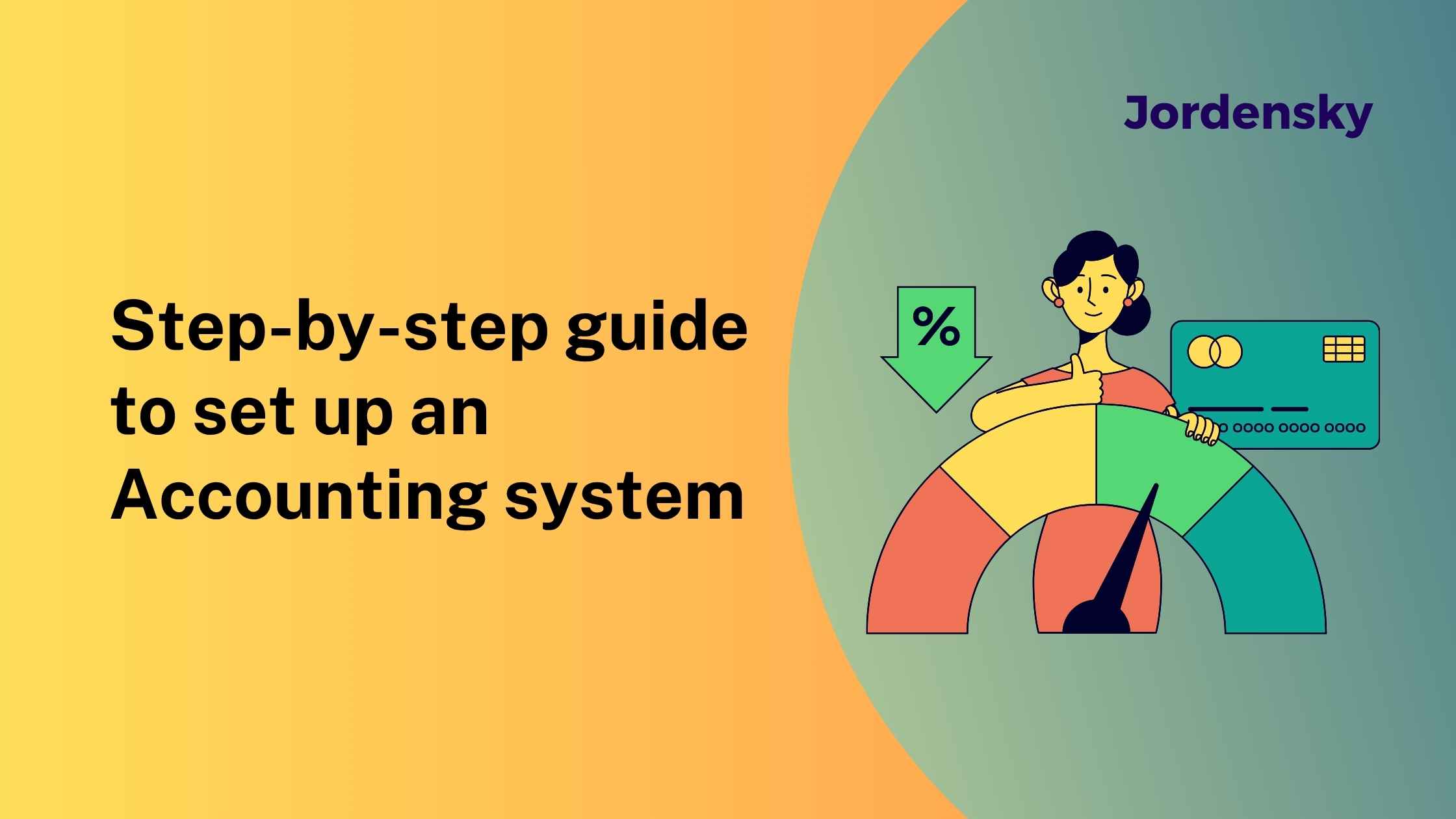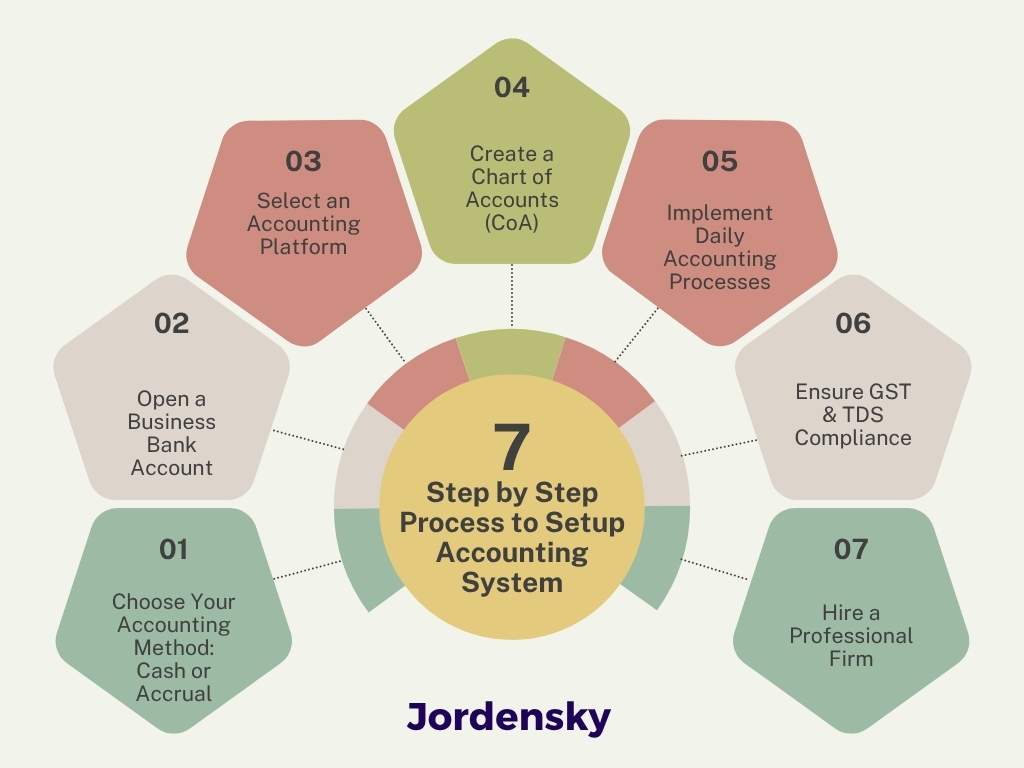Step-by-step guide to set up an accounting system in India

In India’s fast-growing business environment, an accounting system isn’t just a ledger — it’s the backbone of compliance, financial clarity, and investor trust.
Yet many startups delay this step, relying on spreadsheets or informal tracking, until a missed GST deadline or investor due diligence forces a costly clean-up.
Whether you’re:
…this guide will walk you through how to set up an accounting system in India the right way — from choosing the correct accounting method to building a compliance-ready chart of accounts.
Tip for Foreign Businesses: If you’re entering India, your accounting must align with Indian GAAP, GST laws, and possibly IFRS. See our detailed Accounting for Foreign Companies in India guide.
Business Impact:
Decide whether to use cash or accrual accounting based on your business model; accrual gives a clearer financial picture for scaling startups while cash basis may suit microbusinesses. For Indian private limited companies and investor-backed startups, accrual is generally recommended to meet Companies Act and investor expectations when you setup an accounting system. Document your choice in policy notes so future auditors and partners understand why you selected that method.
Cash Basis:
Accrual Basis:
Comparison Table:
Open a dedicated current account in the company name and complete bank KYC (PAN, registration certificate, proof of address) to keep personal and business funds separate — a must when you set up an accounting system for compliance. Choose a bank with good online banking and API options so you can automate transaction imports into your accounting software and speed up reconciliations. Maintaining this separation reduces audit risk and simplifies GST input credit matching, especially for startups and foreign entities operating in India.
Why It’s Crucial:
Required Documents (India):
Pro Tip: Choose a bank that offers API integrations with accounting software like Zoho Books or Tally for automated transaction imports.
Pick a GST-ready accounting platform (TallyPrime, Zoho Books, Jordensky etc.) that supports your workflows, scalability, and — if needed — multi-currency for foreign companies looking to build an accounting system in India. Evaluate integration with payroll, invoicing, e-commerce, and bank feeds; automation reduces errors and improves month-end close times. Prioritise software with robust reporting and role-based access controls to demonstrate expertise and trustworthiness during investor or regulatory reviews.
Popular Options in India:
Selection Checklist:
Design a clean chart of accounts tailored to your industry (assets, liabilities, income, expenses) so financial statements are meaningful and consistent when you set up a chart of accounts for your startup. Map GST-liable transactions (HSN/SAC codes) and common tax buckets (GST payable, TDS payable) into the chart to speed filings and reconcile input credits. Keep the CoA simple at first, then expand with subaccounts as you scale to avoid unnecessary complexity.
Example for an SaaS Startup:
Assets:
Liabilities:
Income:
Expenses:
Create standard processes for issuing GST-compliant invoices, recording purchases, logging receipts, and reconciling bank statements daily or weekly — these are the core of a set up a simple accounting system that scales. Automate recurring invoices, payment reminders, and document capture to reduce manual work and improve cash flow forecasting. Regular housekeeping (monthly reconciliations, aged receivables review) keeps your books audit-ready and supports faster decision-making.
Build compliance steps directly into your accounting workflows: capture GSTINs, validate invoices, file GSTR-1/GSTR-3B on time, and calculate TDS for vendors and salaries to avoid penalties when you learn the key steps, best practices, and costs of running accounts in India. For foreign companies, include withholding rules, place of supply considerations, and RBI reporting in your compliance checklist to ensure inbound/outbound transactions are correctly treated. Use periodic CA reviews to identify mismatches, blocked ITC, and to certify tax positions before audits.
GST Compliance Tips:
TDS Compliance Tips:
Engage a qualified Chartered Accountant like Jordensky to set up your chart of accounts, define accounting policies, and perform quarterly reviews so your setup accounting system meets statutory requirements and investor expectations. Schedule recurring checkpoints (monthly bookkeeping review, quarterly tax review, annual audit prep) to keep controls strong and financial statements credible.
A CA / Professional Accounting Firm can:

Foreign companies need to:
📌 Full guide here: Accounting for Foreign Companies in India
A foreign SaaS company entering India initially used its US accounting system without local adjustments. Within months, GST mismatches led to blocked input credits worth ₹3.5 lakh. After migrating to Zoho Books India edition and restructuring their CoA for GST compliance, they avoided further penalties and improved investor reporting accuracy.
Setting up an accounting system in India isn’t just about bookkeeping — it’s about building a compliance shield, a growth foundation, and investor confidence.
If you’re a startup founder or a foreign business entering India, don’t risk costly mistakes. Set it up right from day one with expert help.